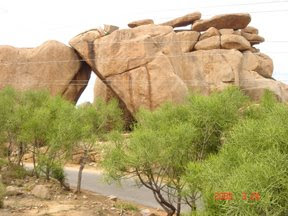
See our You Tube Video
Daroji Sloth Bear Sanctuary, Karnataka
As we entered Hampi, the ancient city of Vijayanagar, scattered with the ruins of bygone splendour in granite stone, WILDLIFE was far from my thoughts. Still, a simple board announcing "Daroji Bear sanctuary just 15 km from here" caught my eye. We asked our guide if it was worth the trip. "sure," he said," be there between four and five in the evening and you are sure to see the sloth bears”. I looked at the watch. It was 11 am. After walking through the Vitthala and Virupaksha temples during the day we can hope to make it to the sanctuary before dark since we had hired a vehicle for the day.
I had heard about Wildlife SOS rescuing dancing bears and releasing them in rescue centres. May be this was one of them, I thought to myself. We reached the sanctuary in the evening, after driving through barren stone covered landscape for the most part. We drove through the sanctuary gate into an expanse of more granite blobs and keekar trees. Well placed sign boards throughout the sanctuary (the sign boards were there on the road along the drive to Daroji too) made sure we reached the watch tower by 5.30 pm or so.
To our surprise, there were a few tourists including a forest guard already there waiting for the bears to come out of their stone caves and descend to the tree and stone top where platefuls of jaggery had been placed by the guards to lure them. The bears are wild and are the residents of this area since time immemorial. Besides sloth bears, leopards, wild boar ( the symbol of both Chalukia and Vijayanagara dynasty) and peacocks are easily seen, the forest guard said. The peafowl were already tasting the food on the trees. Wild boars cannot climb the trees but a couple of them patiently waited for the bears, hoping for crumbs falling to the ground, no doubt.
Everyone was quiet and the only sounds were those of the partridges, which could be seen scampering about. ‘There he is’, muffled cries went out. A huge black figure had come out and was on his hind legs searching for something on a high rock cleft. ‘There is some food there too’-the guard informed. Soon three more bears emerged from under the rocks-huge hefty and black -very unlike the craggy bears one remembered from childhood-the bears, which danced for the kalandahar.
One huge bear climbed the tree and started eating. Peafowl and boars in attendance on the ground. One could watch the magnificent creatures through some powerful binoculars. They were too far away for my still camera to capture them.
I remembered seeing sloth bears in Ranthambore a few years back. I had also seen them in Corbett National Park during a visit nearly 25 years ago. ( See a snap of the bear which came to Dhikala below). From those days the sloth bears have reduced steadily in numbers due to poaching and habitat destruction that the forest department found it necessary to protect the species in an exclusive sanctuary. The sanctuary was formed in the year 1994.
The rock-strewn hillocks that stretch between Daroji of Sandur taluk and Ramasagar of Hospet Taluk in Bellary district have been the abode of Indian Sloth Bear (Melursus ursimus) since ages. In October 1994, the Government of Karnataka declared 5,587.30 hectares of Bilikallu reserve forest as Daroji Bear Sanctuary.
It is estimated that about 120 Sloth Bears are living in this sanctuary, apart from Leopards, Hyena, Jackals, Wild Boars, Porcupine, Pangolins, Star Tortoise, Monitor Lizard, Mongoose, Pea Fowls, Partridges, Painted Spur Hen, Quails etc. About 90 species of birds, and 27 species of butterflies have also been identified in this sanctuary in a preliminary survey.

